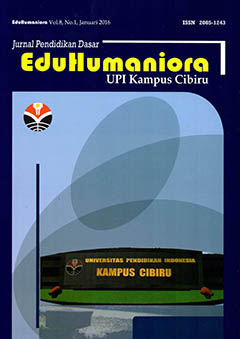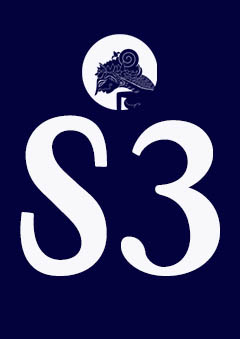PEREKAYASAAN MODEL PEMBELAJARAN MEMBACA PERMULAAN DI SEKOLAH DASAR BERBASIS PENGEMBANGAN SIKAP, KETERAMPILAN, DAN PENGETAHUAN
Abstract
Abstract: The research objective to be achieved through the second year the study was to determine, explain, and explain (1) the prototype model of learning to read beginning in early elementary school classes in accordance with the needs of teachers and students current conditions based on the results of the validation test; (2) the contribution of the implementation of Early reading learning model-based development of attitudes, skills and knowledge to the development of students' skills in reading starters based on the results of the validation test; (3) the contribution of the implementation of Early reading learning model-based development of attitudes, skills and knowledge to primary school students' knowledge acquisition thematically based on the results of the validation test. This research was conducted using the method of Research and Development (R & D). The subjects were teachers and students of primary schools in the district and sub-district Cileunyi Ujungberung Bandung Regency Bandung. Research data will be collected using several instruments. Research data will be processed using data processing techniques of qualitative and quantitative data processing techniques with statistical test. Based on the results of the study concluded that the learning model based SKP Early reading can be used effectively to improve student reading skills beginning. The second conclusion is that the learning model based SKP Early reading can be used effectively in improving students' attitudes Early reading. Based on this fact, the model can be used in schools as an alternative model of learning to read in low grade.
Keywords: SKP models, read the beginning, the attitude of reading, low grade
Abstrak: Tujuan penelitian yang hendak dicapai melalui penelitian tahun kedua adalah untuk mengetahui, menjelaskan, dan memaparkan (1) prototipe model pembelajaran membaca permulaan di kelas awal sekolah dasar yang sesuai dengan kebutuhan guru dan kondisi siswa saat ini berdasarkan hasil uji validasi; (2) kontribusi penerapan model pembelajaran membaca permulaan berbasis pengembangan sikap, keterampilan, dan pengetahuan terhadap perkembangan keterampilan siswa dalam membaca permulaan berdasarkan hasil uji validasi; (3) kontribusi penerapan model pembelajaran membaca permulaan berbasis pengembangan sikap, keterampilan, dan pengetahuan terhadap perolehan pengetahuan siswa sekolah dasar secara tematis berdasarkan hasil uji validasi. Penelitian ini dilaksanakan dengan menggunakan metode Penelitian dan Pengembangan (R&D). Subjek penelitian ini adalah guru dan siswa sekolah dasar di Kecamatan Cileunyi Kabupaten Bandung dan Kecamatan Ujungberung Kota Bandung. Data Penelitian akan dikumpulkan dengan menggunakan beberapa instrumen. Data hasil penelitian akan diolah dengan menggunakan teknik pengolahan data kualitatif dan teknik pengolahan data kuantitatif dengan uji statistika. Berdasarkan hasil penelitian disimpulkan bahwa model pembelajaran membaca permulaan berbasis SKP dapat digunakan secara efektif dalam meningkatkan kemampuan membaca permulaan siswa. Simpulan yang kedua adalah bahwa model pembelajaran membaca permulaan berbasis SKP dapat digunakan secara efektif dalam meningkatkan sikap membaca permulaan siswa. Berdasarkan kenyataan tersebut, model yang dikembangkan dapat digunakan di sekolah sebagai salah satu alternatif model pembelajaran membaca di kelas rendah.
Kata Kunci: model SKP, membaca permulaan, sikap membaca, kelas rendah
Full Text:
PDFReferences
Axfor, Harders, & Wise (2009) Scaffolding Literacy. Australia: ACER Press.
Bryant, D.P., dkk. (2009). “Instructional Strategies for Content-Area Reading Instruction”. Intervention in School and Clinic. 34 (5). 293–302.
Durukan dan Alver (2008). “Uluslararası Sosyal Arastırmalar Dergisi”. The Journal of International Social Research. 1 (5). 274–289.
Fien, et al. (2010). “Including English Learners in a Multitiered Approach to Early Reading Instruction and Intervention”. Assessment for Effective Intervention. 36 (3). 143–157.
Fox, B. J. (2000). Word Identification Strategies: Phonics from a New Perspective (2nd ed.). Upper Saddle River, NJ: Prentice Hall.
Gall, M.D. et al. (2001) Educational Research: An Introduction. New York: Allyn and Bacon.
Greenleaf, C.L. dkk. (2010) “Integrating Literacy and Science in Biology: Teaching and Learning Impacts of Reading Apprenticeship Professional Development”. American Educational Research Journal. 44 (1). 647–717.
Hamra, A dan Syatriana, E. (2012). “A Model of Reading Teaching for University EFL Students: Need Analysis and Model Design. English Language Teaching. 5 (10). 1–11.
Joyce, B. dkk. (2001) Models of Teaching. New York: Allyn and Bacon.
Lance, et. al. (2003). “Addressing Literacy: Effective Methods for Reading Instruction” Communication Disorders Quarterly.25 (1). 5–11.
Merkuri, Z. (2011). “Proscess of Teaching Reading in Middle and Hihg Schools: an Approach of Programs That Work”. Social and Natural Jounal. 4 (1). 24–27.
Minium, E. and King B. (1993).Statistical Reasioning in Psychology and Education. Canada: John Wiley & Sons. Inc.
Mol et al. (2009). Interactive Book Reading in Early Education: A Tool to Stimulate Print Knowledge as Well as Oral Language. Review of Educational Research. 79 (2). 979 – 1007.
Nurhasanah, E. dan Kusnandar, Y. (2006) Penuntut Penggunaan Metode Cantol Roudhoh. Bandung: Mumtaz Agency.
O’Connor, et al. (2005). Layers of Reading Intervention in Kindergarten Through Third Grade: Changes in Teaching and Student Outcomes. Journal of Learning Disabilities. 38 (5). 440–455.Sánchez (2013)
Shanahan, T and Lonigan, C. J. (2010), et. al. (2003). “Addressing Literacy: Effective Methods for Reading Instruction” Communication Disorders Quarterly.25 (1). 5–11.
Slavin, et al. (2009). Effective Reading Programs for the Elementary Grades: A Best-Evidence Synthesis. Review Of Educational Research. 79 (4). 1391–1466.
Sonnenschein, S., Stapleton, L.M. dan Benson, A. (2009). “The Relation Between the Type and Amount of Instruction and Growth in Children's Reading Competencies”. American Educational Research Journal. 47 (2). 358 – 389.
Stake, R.E. (2010). Qualitative research: studying how things work. Thousand Oaks, CA: Sage Publications.
Swason, et al. (2011). “A Synthesis of Read-Aloud Interventions on Early Reading Outcomes Among Preschool Through Third Graders at Risk for Reading Difficulties”. Journal of Learning Disabilities. 44 (3). 258 – 275.
Walton, P. D., & Walton, L.M. (2002). “Beginning Reading by Teaching in Rime Analogy: Effects on Phonological Skills, Letter-Sound Knowledge, Working Memory, and Word-Reading Strategies. Scientific Studies of Reading. 6(1). 79–115.
Yao (2012).“A Study on Strategies-Based Reading Instruction at College Level”. Studies in Literature and Language. 4(3). 50–54.
DOI: https://doi.org/10.17509/eh.v9i1.6270
Refbacks
- There are currently no refbacks.
Copyright (c) 2017 Kampus Cibiru 2016
EduHumaniora: Jurnal Pendidikan Dasar
Published in collaboration Program Studi PGSD UPI Kampus Cibiru
and
HDPGSDI
This work is licensed under a Creative Commons Attribution-ShareAlike 4.0 International License.















